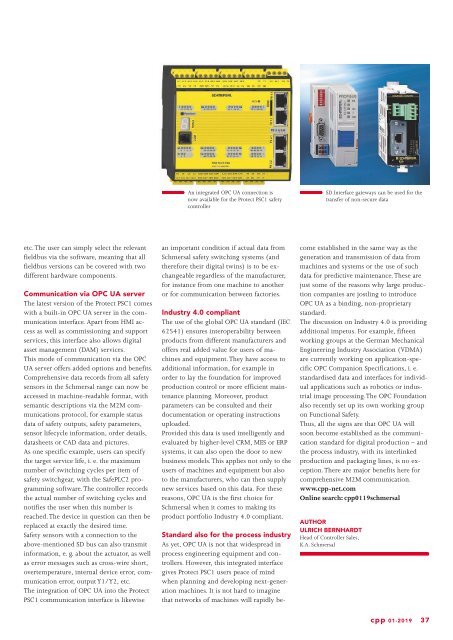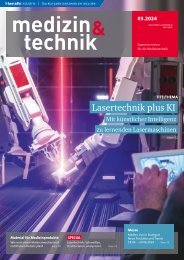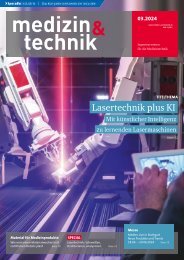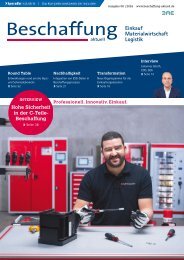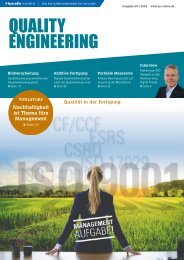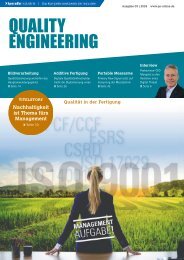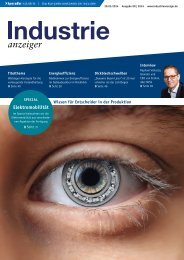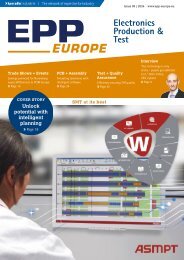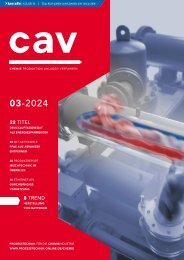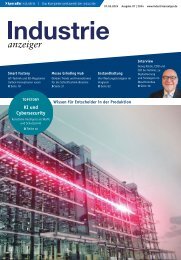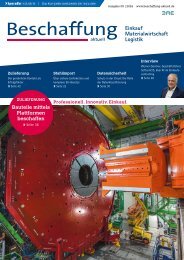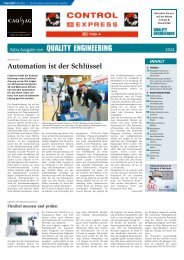cpp – Process technology for the chemical industry 01.2019
The journal cpp - Process technology for the chemical industry reports about processes, plants, apparatus and components for the chemical and pharmaceutical industry. Further topics are IT technologies, industry 4.0, digital production, MSR and automation technology and process analysis technology. The content spectrum is rounded off by explosion protection, plant safety, occupational health and safety, maintenance, site management and energy management.
The journal cpp - Process technology for the chemical industry reports about processes, plants, apparatus and components for the chemical and pharmaceutical industry. Further topics are IT technologies, industry 4.0, digital production, MSR and automation technology and process analysis technology. The content spectrum is rounded off by explosion protection, plant safety, occupational health and safety, maintenance, site management and energy management.
Create successful ePaper yourself
Turn your PDF publications into a flip-book with our unique Google optimized e-Paper software.
An integrated OPC UA connection is<br />
now available <strong>for</strong> <strong>the</strong> Protect PSC1 safety<br />
controller<br />
SD Interface gateways can be used <strong>for</strong> <strong>the</strong><br />
transfer of non-secure data<br />
etc. The user can simply select <strong>the</strong> relevant<br />
fieldbus via <strong>the</strong> software, meaning that all<br />
fieldbus versions can be covered with two<br />
different hardware components.<br />
Communication via OPC UA server<br />
The latest version of <strong>the</strong> Protect PSC1 comes<br />
with a built-in OPC UA server in <strong>the</strong> communication<br />
interface. Apart from HMI access<br />
as well as commissioning and support<br />
services, this interface also allows digital<br />
asset management (DAM) services.<br />
This mode of communication via <strong>the</strong> OPC<br />
UA server offers added options and benefits.<br />
Comprehensive data records from all safety<br />
sensors in <strong>the</strong> Schmersal range can now be<br />
accessed in machine-readable <strong>for</strong>mat, with<br />
semantic descriptions via <strong>the</strong> M2M communications<br />
protocol, <strong>for</strong> example status<br />
data of safety outputs, safety parameters,<br />
sensor lifecycle in<strong>for</strong>mation, order details,<br />
datasheets or CAD data and pictures.<br />
As one specific example, users can specify<br />
<strong>the</strong> target service life, i. e. <strong>the</strong> maximum<br />
number of switching cycles per item of<br />
safety switchgear, with <strong>the</strong> SafePLC2 programming<br />
software. The controller records<br />
<strong>the</strong> actual number of switching cycles and<br />
notifies <strong>the</strong> user when this number is<br />
reached. The device in question can <strong>the</strong>n be<br />
replaced at exactly <strong>the</strong> desired time.<br />
Safety sensors with a connection to <strong>the</strong><br />
above-mentioned SD bus can also transmit<br />
in<strong>for</strong>mation, e. g. about <strong>the</strong> actuator, as well<br />
as error messages such as cross-wire short,<br />
overtemperature, internal device error, communication<br />
error, output Y1/Y2, etc.<br />
The integration of OPC UA into <strong>the</strong> Protect<br />
PSC1 communication interface is likewise<br />
an important condition if actual data from<br />
Schmersal safety switching systems (and<br />
<strong>the</strong>re<strong>for</strong>e <strong>the</strong>ir digital twins) is to be exchangeable<br />
regardless of <strong>the</strong> manufacturer,<br />
<strong>for</strong> instance from one machine to ano<strong>the</strong>r<br />
or <strong>for</strong> communication between factories.<br />
Industry 4.0 compliant<br />
The use of <strong>the</strong> global OPC UA standard (IEC<br />
62541) ensures interoperability between<br />
products from different manufacturers and<br />
offers real added value <strong>for</strong> users of machines<br />
and equipment. They have access to<br />
additional in<strong>for</strong>mation, <strong>for</strong> example in<br />
order to lay <strong>the</strong> foundation <strong>for</strong> improved<br />
production control or more efficient maintenance<br />
planning. Moreover, product<br />
parameters can be consulted and <strong>the</strong>ir<br />
documentation or operating instructions<br />
uploaded.<br />
Provided this data is used intelligently and<br />
evaluated by higher-level CRM, MES or ERP<br />
systems, it can also open <strong>the</strong> door to new<br />
business models. This applies not only to <strong>the</strong><br />
users of machines and equipment but also<br />
to <strong>the</strong> manufacturers, who can <strong>the</strong>n supply<br />
new services based on this data. For <strong>the</strong>se<br />
reasons, OPC UA is <strong>the</strong> first choice <strong>for</strong><br />
Schmersal when it comes to making its<br />
product portfolio Industry 4.0 compliant.<br />
Standard also <strong>for</strong> <strong>the</strong> process <strong>industry</strong><br />
As yet, OPC UA is not that widespread in<br />
process engineering equipment and controllers.<br />
However, this integrated interface<br />
gives Protect PSC1 users peace of mind<br />
when planning and developing next-generation<br />
machines. It is not hard to imagine<br />
that networks of machines will rapidly become<br />
established in <strong>the</strong> same way as <strong>the</strong><br />
generation and transmission of data from<br />
machines and systems or <strong>the</strong> use of such<br />
data <strong>for</strong> predictive maintenance. These are<br />
just some of <strong>the</strong> reasons why large production<br />
companies are jostling to introduce<br />
OPC UA as a binding, non-proprietary<br />
standard.<br />
The discussion on Industry 4.0 is providing<br />
additional impetus. For example, fifteen<br />
working groups at <strong>the</strong> German Mechanical<br />
Engineering Industry Association (VDMA)<br />
are currently working on application-specific<br />
OPC Companion Specifications, i. e.<br />
standardised data and interfaces <strong>for</strong> individual<br />
applications such as robotics or industrial<br />
image processing. The OPC Foundation<br />
also recently set up its own working group<br />
on Functional Safety.<br />
Thus, all <strong>the</strong> signs are that OPC UA will<br />
soon become established as <strong>the</strong> communication<br />
standard <strong>for</strong> digital production <strong>–</strong> and<br />
<strong>the</strong> process <strong>industry</strong>, with its interlinked<br />
production and packaging lines, is no exception.<br />
There are major benefits here <strong>for</strong><br />
comprehensive M2M communication.<br />
www.<strong>cpp</strong>-net.com<br />
Online search: <strong>cpp</strong>0119schmersal<br />
AUTHOR:<br />
ULRICH BERNHARDT<br />
Head of Controller Sales,<br />
K.A. Schmersal<br />
<strong>cpp</strong> 01-2019 37


